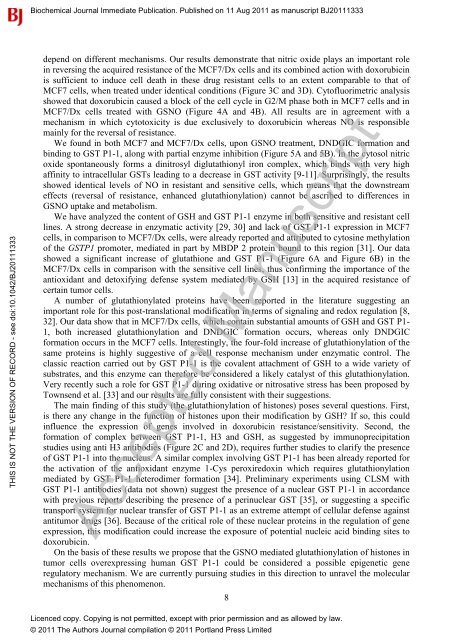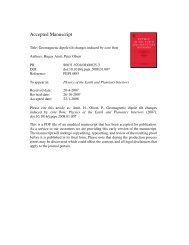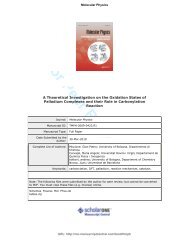1 TREATMENT OF DOXORUBICIN RESISTANT MCF7/Dx ... - TARA
1 TREATMENT OF DOXORUBICIN RESISTANT MCF7/Dx ... - TARA
1 TREATMENT OF DOXORUBICIN RESISTANT MCF7/Dx ... - TARA
You also want an ePaper? Increase the reach of your titles
YUMPU automatically turns print PDFs into web optimized ePapers that Google loves.
Biochemical Journal Immediate Publication. Published on 11 Aug 2011 as manuscript BJ20111333<br />
THIS IS NOT THE VERSION <strong>OF</strong> RECORD - see doi:10.1042/BJ20111333<br />
depend on different mechanisms. Our results demonstrate that nitric oxide plays an important role<br />
in reversing the acquired resistance of the <strong>MCF7</strong>/<strong>Dx</strong> cells and its combined action with doxorubicin<br />
is sufficient to induce cell death in these drug resistant cells to an extent comparable to that of<br />
<strong>MCF7</strong> cells, when treated under identical conditions (Figure 3C and 3D). Cytofluorimetric analysis<br />
showed that doxorubicin caused a block of the cell cycle in G2/M phase both in <strong>MCF7</strong> cells and in<br />
<strong>MCF7</strong>/<strong>Dx</strong> cells treated with GSNO (Figure 4A and 4B). All results are in agreement with a<br />
mechanism in which cytotoxicity is due exclusively to doxorubicin whereas NO is responsible<br />
mainly for the reversal of resistance.<br />
We found in both <strong>MCF7</strong> and <strong>MCF7</strong>/<strong>Dx</strong> cells, upon GSNO treatment, DNDGIC formation and<br />
binding to GST P1-1, along with partial enzyme inhibition (Figure 5A and 5B). In the cytosol nitric<br />
oxide spontaneously forms a dinitrosyl diglutathionyl iron complex, which binds with very high<br />
affinity to intracellular GSTs leading to a decrease in GST activity [9-11]. Surprisingly, the results<br />
showed identical levels of NO in resistant and sensitive cells, which means that the downstream<br />
effects (reversal of resistance, enhanced glutathionylation) cannot be ascribed to differences in<br />
GSNO uptake and metabolism.<br />
We have analyzed the content of GSH and GST P1-1 enzyme in both sensitive and resistant cell<br />
lines. A strong decrease in enzymatic activity [29, 30] and lack of GST P1-1 expression in <strong>MCF7</strong><br />
cells, in comparison to <strong>MCF7</strong>/<strong>Dx</strong> cells, were already reported and attributed to cytosine methylation<br />
of the GSTP1 promoter, mediated in part by MBDP 2 protein bound to this region [31]. Our data<br />
showed a significant increase of glutathione and GST P1-1 (Figure 6A and Figure 6B) in the<br />
<strong>MCF7</strong>/<strong>Dx</strong> cells in comparison with the sensitive cell lines, thus confirming the importance of the<br />
antioxidant and detoxifying defense system mediated by GSH [13] in the acquired resistance of<br />
certain tumor cells.<br />
A number of glutathionylated proteins have been reported in the literature suggesting an<br />
important role for this post-translational modification in terms of signaling and redox regulation [8,<br />
32]. Our data show that in <strong>MCF7</strong>/<strong>Dx</strong> cells, which contain substantial amounts of GSH and GST P1-<br />
1, both increased glutathionylation and DNDGIC formation occurs, whereas only DNDGIC<br />
formation occurs in the <strong>MCF7</strong> cells. Interestingly, the four-fold increase of glutathionylation of the<br />
same proteins is highly suggestive of a cell response mechanism under enzymatic control. The<br />
classic reaction carried out by GST P1-1 is the covalent attachment of GSH to a wide variety of<br />
substrates, and this enzyme can therefore be considered a likely catalyst of this glutathionylation.<br />
Very recently such a role for GST P1-1 during oxidative or nitrosative stress has been proposed by<br />
Townsend et al. [33] and our results are fully consistent with their suggestions.<br />
The main finding of this study (the glutathionylation of histones) poses several questions. First,<br />
is there any change in the function of histones upon their modification by GSH? If so, this could<br />
influence the expression of genes involved in doxorubicin resistance/sensitivity. Second, the<br />
formation of complex between GST P1-1, H3 and GSH, as suggested by immunoprecipitation<br />
studies using anti H3 antibodies (Figure 2C and 2D), requires further studies to clarify the presence<br />
of GST P1-1 into the nucleus. A similar complex involving GST P1-1 has been already reported for<br />
the activation of the antioxidant enzyme 1-Cys peroxiredoxin which requires glutathionylation<br />
mediated by GST P1-1 heterodimer formation [34]. Preliminary experiments using CLSM with<br />
GST P1-1 antibodies (data not shown) suggest the presence of a nuclear GST P1-1 in accordance<br />
with previous reports describing the presence of a perinuclear GST [35], or suggesting a specific<br />
transport system for nuclear transfer of GST P1-1 as an extreme attempt of cellular defense against<br />
antitumor drugs [36]. Because of the critical role of these nuclear proteins in the regulation of gene<br />
expression, this modification could increase the exposure of potential nucleic acid binding sites to<br />
doxorubicin.<br />
On the basis of these results we propose that the GSNO mediated glutathionylation of histones in<br />
tumor cells overexpressing human GST P1-1 could be considered a possible epigenetic gene<br />
regulatory mechanism. We are currently pursuing studies in this direction to unravel the molecular<br />
mechanisms of this phenomenon.<br />
Accepted Manuscript<br />
8<br />
Licenced copy. Copying is not permitted, except with prior permission and as allowed by law.<br />
© 2011 The Authors Journal compilation © 2011 Portland Press Limited
















